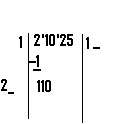Cube Root
If any number x is multiplied itself three times, the result is called x cube.
x*x*x = x³ _
There fore x = Cube Root of x³ = ³√x³
Please find the below table for the Cubes of 1 to 9.
Here we can notice, Cube of 3 ends with 7, 4 ends with 4, 5 ends with 5, 6 ends with 6, 7 ends with 3, 8 ends with 2 and 9 ends with 9.
Perfect Cube: 1, 8, 27, 64, 125, 216, 343, 512, 729, ..... are called Perfect Cubes whose Cube Roots are exact numbers. Any Real number multiplied itself three times, the cube is called Perfect Cube.
Easy Method for finding out Cube Roots for Perfect Cube:
Example 1: To find out Cube Root of 421875.
Solution: By grouping each 3 digits from right to left of 421875 is 421'875.
Now take the 1st group from left, which is 421 guess the which cube is maximum and less than or equal to 421. We can guess 7, as the cube of 7 is 343 will satisfy the condition. And next group from left is 875, ending with 5 means cube of 5.
Long Division Method:
_____
To find out Cube Root of 15625: Denoted by ³√15625
To find out Cube Root of 15625: Denoted by ³√15625
Long Division Method: Set up a division with the number, with grouping each 3 digits from the decimal point to left.
Take the 1 st group from left side, which is 15 as new dividend. Check which cube is the maximum and less than equal to 15. 3³ is 27 which is more than 15. So 2³ will satisfy the condition. Now place 2 right sides, and 2³=8 below 15. Subtract 8 from 15, remainder is 7.
Bring down next group 625, and place after 7. So the new dividend is 7625. Now place _² + 30*2(10*2 _) left side as new divisor where 2 is initial quotient, blank is for new quotient and place a blank on right side after 2.
Guess a new quotient to fill in the blanks of the new divisor and quotient such that the product of new quotient and new divisor should be maximum and less than equal to 7625.
We can estimate new quotient from the formula : 380*estimate*2² = present dividend
where 2 is initial quotient
1520*estimate=7625
estimate= 7625/1520 = ~ 5
Choose 5 as the new quotient, and fill the blanks.
New divisor is 5² + 30*2(10*2 +5) = 25 + 1500 = 1525
Then the product = 1525 * 5 = 7625
Place 7625 below 7625, and subtract. The remainder will be "0". The quotient is 25.
Explanation:
Let ab, a two digit number be the Cube Root of a given number C.
In ab, a is in Tenth place and b is in Units.
The value of ab is 10*a + b.
_
³√C = 10*a + b
cubing both sides
C = (10*a + b)³
C= 1000*a³ + 3*10*a*b*(10*a + b) + b³
C-1000*a³ = 3*10*a*b*(10*a + b) + b³
C-1000*a³ = 30*a*b*(10*a + b) + b³
C-1000*a³ = (30*a*(10*a + b) + b²) * b
LHS is C-1000*a³ which is nothing but remainder after performing with the quotient a.
RHS is (30*a*(10*a + b) + b²) * b which is nothing but the product of new divisor 30*a*(10*a + b) + b² and new quotient b.
We can also write 30*a*(10*a+b) +b² as 30*a* ab +b² where ab is not a*b.
In each operation, if the new quotient is b then the new divisor will be 30*a*(10*a + b) + b² where a is initial quotient.
LHS is C-1000*a³ which is nothing but remainder after performing with the quotient a.
RHS is (30*a*(10*a + b) + b²) * b which is nothing but the product of new divisor 30*a*(10*a + b) + b² and new quotient b.
We can also write 30*a*(10*a+b) +b² as 30*a* ab +b² where ab is not a*b.
In each operation, if the new quotient is b then the new divisor will be 30*a*(10*a + b) + b² where a is initial quotient.












